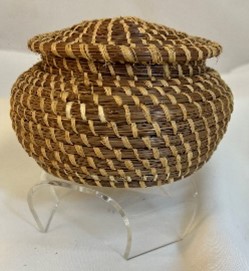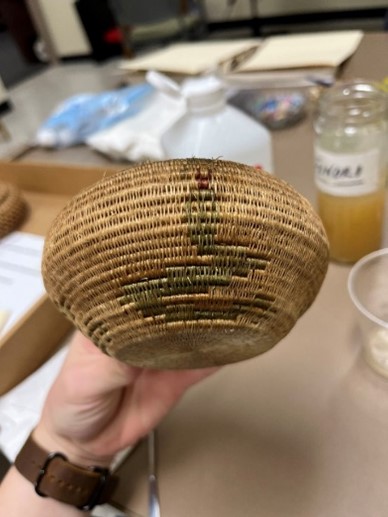The Coushatta of the American Southeast preserves the cultural memories and the practice of basketry by passing down the knowledge of how to create baskets from generation to generation. The baskets are often created as gifts for loved ones on special occasions such as weddings, graduations, and birthdays. These baskets are considered to be family treasures because of the familial stories that are tied to them.
The traditional purpose for baskets like the Round Longleaf Pine Needle and Raffia Basket was to store food and necessities. The baskets may have been used as containers for trading food as well. The Coushatta also began selling round longleaf pine needle baskets to tourists as art, to bring in money. When baskets became popular in the tourist trade, the forms of this basketry started to change from the original round and oval shapes to effigy baskets in the forms of ducks and turkeys, which were more favored for purchase. Traditional round forms like this basket are thus less common today.

Round Longleaf Pine Needle and Raffia Lidded Basket
Coushatta culture
20th century
Longleaf pine needles and raffia
L. 13 cm x W. 13 cm x 6.1 cm
History Museum on the Square collection #2022.1

Round Longleaf Pine Needle and Raffia Lidded Basket
Coushatta culture
20th century
Longleaf pine needles and raffia
L. 13 cm x W. 13 cm x 6.1 cm
History Museum on the Square collection #2022.1
The material, shape, and weaving technique identify this basket as a Mingqaaq basket made by the Inuit culture of the Arctic and Subarctic regions. While these baskets have been made by the Inuit for generations, they do not resemble traditional Inuit baskets; instead, Mingqaaq were likely a form of basketry adopted by the Inuit from the neighboring Yup’ik peoples that were then developed as a type of basket made specifically for the tourist trade. These baskets are made using a tight coiling technique, because this structure is stronger and holds up better to the shipping process than their more traditional twined baskets. Mingqaaq also tend to be small, not only because smaller baskets can be made more quickly, but also because the tourist trade tends to prefer smaller, decorative baskets rather than larger, utilitarian baskets.
When this basket was consolidated during conservation, the decorative motif of a coiled snake, along with a frog above the head of the snake, appeared on each side of the basket. While snakes and frogs are common animals in the Subarctic, serpent images may also refer to the tizheruk, a terrifying sea serpent monster of indigenous mythology.

Finely Woven Inuit Mingqaaq Basket with Snake and Frog Motif
Inuit culture
Early 20th century
Beach grass, L. 11.4 cm x W. 11.6 cm x H. 6.1 cm
BFPC collection #2016.40

Finely Woven Inuit Mingqaaq Basket with Snake and Frog Motif
Inuit culture
Early 20th century
Beach grass, L. 11.4 cm x W. 11.6 cm x H. 6.1 cm
BFPC collection #2016.40
For more information, you may contact the researcher(s) noted in the title of this exhibit entry, or Dr. Billie Follensbee, the professor of the course, at BillieFollensbee@MissouriState.edu
